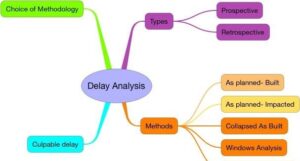Construction Claims
Construction Claims | Management Issues, Common Type of Claims
Construction Claim can be defined as a request by either party to the contract, usually the Contractor, for compensation for damages caused by failure of the other party to fulfil his part of obligations as specified in the contract. The compensation is usually in the form of the additional payment or an extension of time (EOT).
Construction claims are a major hassle, and the only good construction dispute is one that is avoided. Spending time and money on arbitrators, or even worse, on a lengthy and painstaking litigation process, is sure to throw a wrench in your budgetary plans for the year. This article looks at the different types of construction claims and how to stay far away from them. We’ll also share a few thoughts on how to negotiate disputes when they do come up, and how to reach a fair resolution for both parties without wasting time and money with lawyers.
Claim Management
CLAIM MANAGEMENT IN CONSTRUCTION PROJECT MANAGEMENT: AN INEVITABLE PROCESS FOR SUCCESS
As any construction project manager will tell you, claim management is an integral part of the process for achieving successful outcomes. In order to ensure success, it is essential to manage potential issues proactively, with a focus on avoiding claims altogether. This can be achieved through careful management of the breeding grounds for potential claims, alignment of documents, and a business-like approach to entitlements.
Managing the Breeding Grounds for Claims
The first step in effective claim management is to identify and manage the potential breeding grounds for claims. This means taking a proactive approach to risk management and ensuring that all parties involved in the project are aware of potential issues and their associated risks. By identifying these risks early on, it is possible to take steps to mitigate them, thereby reducing the likelihood of claims arising in the first place.
Alignment of Documents
Another important aspect of effective claim management is ensuring that all relevant documents are properly aligned. This includes contracts, specifications, and other project documentation. By ensuring that all parties are working from the same set of information, it is possible to reduce the potential for misunderstandings and disputes, which can lead to claims.
Entitlements in an Efficient and Business-Like Manner
When claims do arise, it is important to address them in a timely and efficient manner. This means entertaining an entitlement in a business-like way, with a focus on achieving a win/win outcome for all parties involved. By taking a considerate approach to early settlement, it is possible to reduce the costs associated with protracted disputes, and to avoid the potential for litigious and arbitral action.
Preventing Stained Relationships, Stalemates, Delays, Disputes, or Loss of Resources
It is essential to prevent the emergence of issues that can cause strained relationships, stalemates, delays, disputes, or loss of resources. In the context of a large construction project, this can be a significant challenge. However, by taking a proactive approach to risk management, and by working to foster open and transparent lines of communication between all parties involved, it is possible to reduce the likelihood of these issues arising.
Claim is a management issue and the process needs efficient and effective management during the entire life cycle of a project.
The Most Common Types of Construction Claims
To get started, let’s look at the types of construction claims that you’re most likely to encounter. This list is by no means exhaustive but should get you thinking about the major sources of disagreement between construction firms and their clients.
When it comes to the construction industry, disputes between construction firms and clients are all too common. One of the main reasons for this is the prevalence of construction claims. These are essentially disagreements between the two parties involved in a construction project about various issues that may arise throughout the project’s duration.
In this article, we’ll explore the most common types of construction claims that you may encounter during a construction project. By understanding these types of claims, you can better prepare yourself for the potential disputes that may arise during your construction project.
- Delay Claims
One of the most common types of construction claims is a delay claim. These are claims that are made when the project takes longer to complete than was originally agreed upon. This can be due to a variety of reasons, such as unexpected changes in weather, unexpected material shortages, or other unforeseen circumstances.
If you’re a construction firm, it’s important to have a plan in place to deal with delay claims. This could involve setting realistic timelines and ensuring that you have enough resources to complete the project on time. On the other hand, if you’re a client, it’s important to understand that delays can happen, and to be patient and understanding when they do.
- Cost Claims
Another common type of construction claim is a cost claim. This type of claim is made when the cost of the project exceeds the amount that was originally agreed upon. This can be due to a variety of reasons, such as changes in the scope of the project or unexpected material or labor costs.
To avoid cost claims, it’s important to have a clear understanding of the project’s scope and to carefully estimate the cost of materials and labor. Additionally, it’s important to communicate any changes to the scope of the project as early as possible to avoid any surprises later on.
- Design Claims
Design claims are made when there are issues with the design of the project. This can include issues such as errors or omissions in the design plans or issues with the functionality of the design. These types of claims can be particularly difficult to resolve, as they often involve complex technical issues.
To avoid design claims, it’s important to have a clear and well-thought-out design plan in place before beginning the project. Additionally, it’s important to have a process in place for addressing any issues that may arise during the project’s construction phase.
- Safety Claims
Safety claims are made when there are issues with the safety of the construction site. This can include issues such as inadequate safety equipment or procedures, or failure to comply with safety regulations. Safety claims are particularly serious, as they can put workers and others at risk.
To avoid safety claims, it’s important to have a strong focus on safety throughout the construction project. This could involve providing adequate safety training to workers, ensuring that safety equipment is in place and functioning properly, and regularly reviewing and updating safety procedures.
- Quality Claims
Quality claims are made when there are issues with the quality of the work that has been done on the project. This can include issues such as poor workmanship or the use of substandard materials. Quality claims can be particularly damaging to a construction firm’s reputation, as they can indicate a lack of professionalism and attention to detail.
To avoid quality claims, it’s important to have a strong focus on quality throughout the construction project. This could involve using high-quality materials and ensuring that work is done to a high standard. Additionally, it’s important to have a process in place for addressing any quality issues that may arise during the project’s construction phase.
Delay Claims
The client files a claim because the project is taking longer than was agreed, and this is resulting in a financial or productivity loss on the part of the customer.
Delay Claims refer to the process of seeking compensation for costs incurred due to a delay in a construction project. This type of claim is typically made when a construction project experiences delays that are not the fault of the contractor or subcontractor, but rather due to factors outside of their control.
The formula used to calculate Delay Claims is typically based on the cost of the project and the length of the delay. One common formula used to calculate Delay Claims is the EOT (Extension of Time) formula, which is calculated as follows:
EOT = (Original Contract Period – Actual Contract Period) – Non-Excusable Delay
In this formula, the Original Contract Period refers to the amount of time originally agreed upon for the completion of the project. The Actual Contract Period refers to the actual amount of time it took to complete the project, including any delays. The Non-Excusable Delay refers to any delay that is outside of the control of the contractor or subcontractor, such as adverse weather conditions or delays caused by third parties.
Another formula that may be used to calculate Delay Claims is the LD (Liquidated Damages) formula. This formula is typically used when the project includes a liquidated damages clause, which is a provision in the contract that specifies a predetermined amount of damages that will be paid if the project is not completed on time. The LD formula is calculated as follows:
LD = (Original Contract Price / Original Contract Period) x Delay in Days
In this formula, the Original Contract Price refers to the total cost of the project as agreed upon in the contract. The Original Contract Period refers to the amount of time originally agreed upon for the completion of the project. The Delay in Days refers to the number of days that the project was delayed beyond the Original Contract Period.
To provide an example of how these formulas may be used, let’s consider a construction project with an Original Contract Period of 180 days and an Original Contract Price of $500,000. Due to inclement weather and delays caused by third parties, the project was delayed by 30 days beyond the Original Contract Period.
Using the EOT formula, we can calculate the Extension of Time as follows:
EOT = (180 – 210) – Non-Excusable Delay EOT = -30 – Non-Excusable Delay
If there were no Non-Excusable Delays, the Extension of Time would be -30 days, meaning that the contractor would be entitled to an extension of time of 30 days to complete the project. However, if there were Non-Excusable Delays, this would need to be subtracted from the Extension of Time.
Using the LD formula, we can calculate the Liquidated Damages as follows:
LD = ($500,000 / 180) x 30 LD = $83,333.33
In this case, if the contract included a liquidated damages clause, the contractor would be liable to pay $83,333.33 in damages for the 30-day delay in the completion of the project.
Price Acceleration Claims
From time to time, contractors will be required to exceed project budgets to complete a project on time or ahead of schedule. Price acceleration claims arise from disagreements between the contractor and client on who is legally required to bear the costs of accelerating work.
Example:
Price acceleration claims refer to situations where the rate of increase in prices for a certain commodity or group of commodities exceeds a predetermined level. The term is often used in the context of insurance claims, where it may be necessary to determine whether a policyholder is entitled to compensation for a loss related to price increases.
One common way to calculate price acceleration is to use a formula that compares the current rate of price increase to a baseline rate. The baseline rate is typically set based on historical data and is used to establish what would be considered a “normal” rate of price increase. If the current rate of price increase exceeds the baseline rate by a certain percentage, then a price acceleration claim may be justified.
The formula for calculating price acceleration is as follows:
(Current rate of price increase – Baseline rate of price increase) / Baseline rate of price increase
For example, suppose that the baseline rate of price increase for a certain commodity is 2% per year, based on historical data. If the current rate of price increase for that commodity is 4% per year, then the price acceleration would be:
(4% – 2%) / 2% = 100%
This indicates that the current rate of price increase is double the baseline rate, which may be considered significant enough to warrant a price acceleration claim.
Another way to express the same concept is to use the “acceleration factor,” which is the ratio of the current rate of price increase to the baseline rate. The acceleration factor can be calculated using the following formula:
Current rate of price increase / Baseline rate of price increase
Using the same example as before, the acceleration factor would be:
4% / 2% = 2
This indicates that the current rate of price increase is twice the baseline rate, which is consistent with the previous calculation.
In practice, price acceleration claims may involve more complex calculations and considerations, such as the specific terms of the insurance policy and the nature of the loss being claimed. However, the basic concept of comparing the current rate of price increase to a baseline rate remains the same.
Change of Work Order Claims
These claims are related to the scope of work and whether a required change falls within the preexisting scope of work or not.
Example:
Change of Work Order Claims refer to a type of claim made by contractors when they incur additional costs due to changes made to the original project plan by the owner or client. This change can be related to the scope of work, design, specifications, or any other aspect that may impact the project’s cost.
The formula used to calculate Change of Work Order Claims is:
Change of Work Order Claims = (New Cost of Work) – (Original Contract Sum) +/- (Direct/Indirect Cost Impact)
Where:
- New Cost of Work: the total cost of the work performed after the change order has been made.
- Original Contract Sum: the original amount agreed upon by the contractor and the owner/client for the entire project.
- Direct/Indirect Cost Impact: additional costs incurred due to the change order that are directly or indirectly related to the project, such as labor, materials, equipment, and overhead costs.
It’s important to note that the +/- sign in the formula depends on whether the change order results in a cost increase or decrease. If the change order results in a cost increase, the sign is “+”. If it results in a cost decrease, the sign is “-“.
For example, let’s say the original contract sum was $100,000, and the new cost of work after the change order is $120,000. Additionally, there were $5,000 of direct costs and $3,000 of indirect costs incurred due to the change order. In this case, the Change of Work Order Claims would be calculated as follows:
Change of Work Order Claims = ($120,000) – ($100,000) + ($5,000 + $3,000) Change of Work Order Claims = $28,000
This means that the contractor is entitled to a claim of $28,000 for the additional costs incurred due to the change order.
In summary, Change of Work Order Claims is a formula used to calculate the additional costs incurred by contractors due to changes made to the original project plan by the owner/client. This formula takes into account the new cost of work, the original contract sum, and the direct/indirect cost impact of the change order.
Different Site Conditions Claims
These claims arise out of differences between the actual condition of the job site and the way it is represented by the client in the contract. For example, if the job site is meant to be a grass field, but the contractor arrives and finds a gravel pit, it will be costlier to dig a foundation and the contractor can file a claim for different site conditions.
Example:
Different site conditions claims refer to claims made by contractors regarding unforeseen site conditions encountered during construction that cause delays, cost overruns, or other impacts on the project.
There are two main types of different site conditions claims:
- Differing Site Conditions (DSC) Claims: These claims are made when the actual site conditions encountered during construction are different from what was expected or indicated in the contract documents. In order to be successful, the contractor must show that the actual conditions encountered were unforeseeable and that they differ materially from the conditions indicated in the contract documents. The formula for calculating DSC claims is:
DSC = (Actual Site Conditions) – (Contractual Site Conditions)
- Changed Site Conditions (CSC) Claims: These claims are made when the site conditions change during construction due to actions taken by the owner, such as changes in design or scope of work, or due to external factors such as weather or natural disasters. In order to be successful, the contractor must show that the changed site conditions were not reasonably foreseeable and that they materially impact the cost, schedule, or performance of the project. The formula for calculating CSC claims is:
CSC = (Actual Site Conditions) – (Expected Site Conditions)
Examples of DSC and CSC claims:
Example 1: DSC Claim A construction contractor begins excavation for a new building and discovers unforeseen soil conditions, including rock formations, that were not indicated in the contract documents. The cost of the project increases due to the need for specialized equipment and additional labor to excavate the rock. The contractor files a DSC claim for the additional costs incurred due to the unforeseen site conditions.
DSC = (Actual Site Conditions – Contractual Site Conditions) Additional excavation costs = $50,000 Contractual excavation costs = $30,000 DSC claim = $20,000
Example 2: CSC Claim A construction contractor is building a bridge over a river, and the owner decides to change the design of the bridge midway through construction, requiring additional piers to be constructed. This change in design requires additional materials and labor, resulting in increased costs and a delay to the project schedule. The contractor files a CSC claim for the additional costs and schedule impacts due to the changed site conditions.
CSC = (Actual Site Conditions – Expected Site Conditions) Additional bridge piers = $100,000 Expected bridge design = 4 piers Actual bridge design = 6 piers CSC claim = $50,000 (half the cost of the additional piers)
Damage Claims
Damage claims are a type of construction claim that arise when the contractor or subcontractor causes damage to the property of the owner, other contractors, or third parties during the construction project. This damage can be the result of accidents, negligence, or intentional acts.
Examples of damage claims in construction may include a contractor accidentally damaging a neighboring property, a subcontractor damaging a pipe or electrical wiring during installation, or a contractor damaging a historical artifact during excavation.
To pursue a damage claim, the claimant must prove that the damage was caused by the contractor or subcontractor, and that the damage resulted in actual financial losses. This may involve providing evidence of the value of the damaged property, the cost of repairs or replacement, and any loss of use or income resulting from the damage.
Contractors can protect themselves against damage claims by having insurance policies that cover property damage, and by implementing safety protocols to prevent accidents and minimize the risk of property damage. In addition, contractors should carefully document any damage that occurs during the construction project, including photographs, reports, and witness statements, to provide evidence in case a claim is filed.
Overall, damage claims are an important part of the construction industry and can be costly for both the claimant and the contractor. By taking steps to prevent damage and to handle claims in a timely and effective manner, contractors can minimize the risk of damage claims and protect their businesses.
Example:
Damage claims refer to the process of seeking compensation for losses suffered as a result of a third party’s negligence, recklessness or intentional actions. It involves identifying the losses or damages incurred, quantifying their value and making a demand for compensation.
One common formula used in calculating damages is the following:
Damages = (Actual losses + Consequential losses) – (Mitigation + Collateral benefits)
Where:
Actual losses: These are direct losses that have been incurred and can be quantified, such as medical expenses, lost wages, and property damage.
Consequential losses: These are indirect losses that result from the direct losses, such as loss of future earnings or profits.
Mitigation: This refers to any steps taken by the claimant to reduce the losses incurred, such as seeking medical treatment or repairing damaged property.
Collateral benefits: These are any benefits or compensation received by the claimant as a result of the incident, such as insurance payouts or government benefits.
To better illustrate how this formula works, consider the following example:
Suppose a person was involved in a car accident that resulted in $10,000 in medical expenses, $5,000 in lost wages, and $2,000 in property damage. The person also suffered a back injury that prevented them from working for several months, resulting in a loss of $20,000 in future earnings. However, the person had insurance that covered $5,000 of the medical expenses and received $2,000 in government benefits as a result of the accident.
Using the formula, we can calculate the damages as follows:
Damages = ($10,000 + $5,000 + $20,000) – ($5,000 + $2,000) Damages = $28,000 – $7,000 Damages = $21,000
Therefore, the person would be entitled to a damage claim of $21,000.
It’s worth noting that different jurisdictions and types of claims may have different formulas or considerations when calculating damages. It’s important to consult with a qualified legal or financial professional for guidance specific to your situation.
RECOMMENDATION:
1. In the contract the rights and responsibilities of the contractors as well the rights and responsibilities of the owners and engineer should clearly defined.
2. Give reasonable time to the design team to produce clear and complete drawings, bills of quantities, and specifications with no or minimum error and discrepancies.
3. Careful preparation of the contract documents helps to avoid disputes. Therefore, the documents will help to avoid disputes. Therefore the contractor should ask the owner to write the change orders instead of giving oral change orders.
4. Contractor should have signed change (variation) orders before starting doing any change in work on site.
5. Provide a proper mechanism for processing and evaluating change (variation) orders that pay for direct costs, indirect costs, and loss of productivity associated with any changes.
6. The contractor should take care of his work superiority by getting skilled labour and using good management techniques.
7. The government should create a set of procedures to control the quality of the construction work. Also, it should develop licensing contractors to make it more difficult to get certified.
8. The most excellent solution to claim lies in establishment of partnership between the owner and the contractor. Each party should try to solve the problems from the first moment they arise.
9. Use software like MSP, Primavera etc. to make bar charts, critical paths, planning, scheduling, cost control, productivity analysis and most importantly the project progress report to control the delay of the project.
Summary
Construction claims refer to formal requests for compensation or other relief made by contractors, subcontractors, or owners during a construction project. These claims arise when one party believes that the other party has breached the terms of the construction contract, resulting in damages or other losses. Common types of construction claims include delay claims, acceleration claims, changes in scope or design claims, and payment disputes.
To pursue a construction claim, the claimant must follow specific procedures outlined in the construction contract, such as providing notice of the claim within a certain timeframe and submitting supporting documentation. The other party may contest the claim and seek to resolve the dispute through negotiation, mediation, or arbitration. In some cases, the parties may need to go to court to resolve the claim.
Construction claims can be complex and costly, often involving technical issues related to construction standards, schedules, and budgets. To manage the risk of claims, contractors and owners can take steps such as carefully drafting contracts, maintaining detailed records, and engaging in effective communication and dispute resolution practices.








